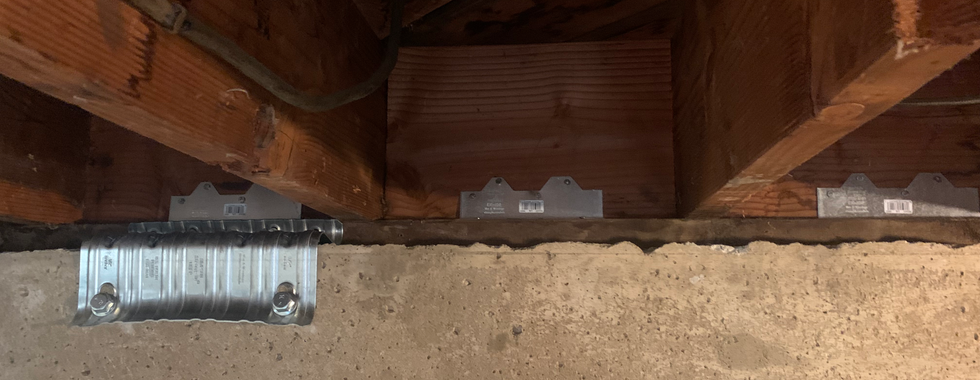A Detailed Look At Seismic Retrofitting
- Ryan Vytlacil
- Feb 8, 2023
- 6 min read
Updated: Jul 19, 2023

A seismic retrofit is an important process that can help protect a home or building from the damage caused by an earthquake. Seismic retrofitting involves strengthening the structure of a building so that it can better withstand seismic activity. In this post, we discuss in detail all the steps of the seismic retrofitting process.
8 Steps of a Seismic Retrofit
Step 1: Anchoring
We always anchor the wood frame of the house to the foundation. Usually a 2x4 sits horizontally on top of the foundation, this is called the sill plate. We anchor the sill with bolts or anchor plates. If you have a cripple wall, we use a traditional anchor bolt, like a Simpson Strongtie Titen HD, see 1a in the graphic above. If the concrete foundation comes all the way up to the joist, then we have no room to install the bolts and we must use an anchor plate, like the Simpson Strongtie URFP, see 1b. Below are some photos of anchors on houses in Seattle.
Anchor bolts embed per engineering drawing but usually 4 inches into the concrete is sufficient. We use 1/2 or 5/8 inch diameter bolts.
A 3x3 square washer on top of anchor bolts is required to prevent the bolt from ripping through the sill plate under load. A round washer is not strong enough.
There are some common scenarios where anchoring is not so straightforward:
1) You have no sill plate
You will need a horizontal member to anchor to. Usually if there is no sill then we cut and install new sill blocks between each stud or joist bay.
2) Sill plate is embedded in the foundation.
Typically we will install new sill blocks between each stud or joist bay and nail the new block to the existing block from above. You will need to use a longer anchor bolts to reach the concrete.
3) Foundation is made from hollow cinder blocks or brick.
Cinderblocks present a challenge because they are hollow. Their strength is also less than that of a concrete foundation. However, they can still relied upon to carry earthquake loads as long as the mortar between the bricks is checked to be in good condition. We use a special epoxy anchor to attach the home. Cinderblocks or CMU (concrete masonry unit) are actually quite common in Seattle and the cost for retrofitting is typically not much more than a traditional foundation type.
Brick foundations can be less suitable than CMU foundations mainly due to age and mortar condition. For brick foundations, we recommend foundation replacement as a consideration, but retrofitting is still possible.
Step 2: Insulation
A simple but important step is to fill any stud bays with insulation before installing plywood over it. Seattle energy code requires this be part of the project. For 2x4 walls R15 is installed, for 2x6 its R19. Insulation will not be required or needed in crawlspace walls. Fiberglass and Rockwool insulation are common varieties.

Step 3: Shear walls
Shear walls are a really important part of the retrofit. This is the process of reinforcing cripple walls in the basement. The basement walls hold the whole house above it, therefore the loads going through it are the highest. It's a weak link in the chain that needs to be upgraded. Remember not all homes have cripple walls so this may not be applicable to your project.
The shear wall is created by nailing plywood to all the studs, and the top and bottom on the wall. A full sheet of plywood is cut down to size and installed on the wall. The nailing pattern around the perimeter and the middle studs is called out by the engineering calculations. Usually it's every 4 inches around the perimeter (edge nailing) and every 12 inches on the middle studs (field nailing). These are installed with a pneumatic nailgun. It's important the nails don't pierce the plywood and get overdriven or else we lose some capacity of the panel, a common mistake. The plywood grade is 1/2 inch CDX and the nails are .131 x 2.5 inches, unless otherwise called out my engineering. It may not seem like much to add plywood to the walls but it does a lot to keep all the studs straight up and down and prevent racking. The shearwall is the main component that transfers load from the upper story into the foundation.
For relatively tall and skinny wall sections (a wall thats taller than it is wide) you will likely receive what is called a hold down, a Simpson Strongtie HDU. Tall walls are susceptible to tipping and HDUs prevent this by resisting uplift in the corners of the wall. The HDUs are embedded deep into the concrete and set with epoxy. We make sure the holes are cleaned really well so the epoxy sticks appropriately to the foundation.

Ideally the whole wall along the house is retrofitted. It's best to distribute the loads across the whole wall so we don't rely on one super strong sections to do all the work. But windows, doors, garage doors, chimneys, finished space like a bathroom, and other openings and obstructions prevent us from retrofitting everywhere. That is OK. As long as we can get around 50% of the wall retrofitted we are in good shape. Less than that will require careful engineering analysis but it can be done.
Step 4: Framing Brackets
Framing Bracket, or shear transfer ties, allow us to transfer load from the joist system into our shear wall. They sit on top of the shear wall and connect the top plate of the wall to the rim joist. The bracket we use for this is the Simpson A35 or L70.
One complicating factor can be that the home has no rim joist, often on walls that run perpendicular to the joists. The rim joist carries load from the upper story so its presence is required. If it's not there then we need to add joist blocks in each joist bay. We cut 2x10 or 2x12 blocks, bracket them like we would normally to the top of the shear wall, and then also attach the block to the subfloor with another bracket.
If there is no cripple wall, then the rim joist is connected directly to the sill plate.

Step 5: Post and Beam connections
As a baseline, we do not recommend post and beam connections such as a T strap, for good reason. If budget allows, and they are accessible, then we can install them but they are not a good bang for buck item. Posts in the middle of the basement are holding up the house. They are gravitational elements. During the retrofit, we are creating a lateral system, meaning a system to prevent the house from moving side to side. To achieve the lateral stability we mainly use the shear walls and other elements we have discussed already. If we dissipate the load safely through the perimeter, there is no substantial movement in the interior, therefore those posts are not seeing a lateral load, therefore bracing them is low value. Additionally, the load capacity of the brackets are not very high so if your home's interior is shifting enough to cause shear load at the posts, the brackets are not going to prevent it from failing.
Step 6: Water heater strapping
Most homes already have their water heater strapped. Double check because you don't want this falling over as they can even in a minor quake. Strapping can avoid flood damage and costly repairs.
Step 7: Gas valves
The most common way a home is damaged in an earthquake is from a fire. The automatic gas shutoff valve detects vibrations of the earthquake and shuts it off. You may not be able to or may not be home at the time to shut it off manual, as you are suppose to after an earthquake.

Step 8: Chimney braces
We install chimney braces when required by the city of Seattle as part of a major remodel, see the directors rule here. The safest way to address chimneys is to demolish them down to the roofline and rebuild it up from there with a steel vent pipe. This keeps the functionality of the fireplace. Completely demolishing it is also a safe option. The drawback to the chimney brace is that your roof and home were not designed to stabilize such a heavy object. The brace can drive failure into other parts of the home. If a brace is used, we recommend a full analysis of the house frame to make sure it's safe. Unfortunately, the city of Seattle requires only the brace and not he additional home framing when it's required during remodels so we urge home owners to be careful.
Thanks for reading! If you think we can help, please book a free appointment.
-Ryan Vytlacil (Owner, Seattle Seismic)
Book a free consultation with us today.









































